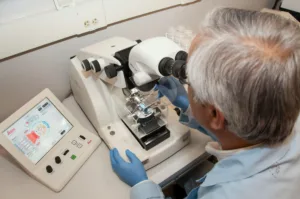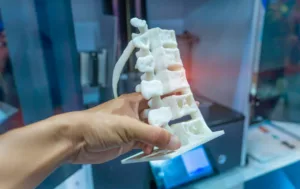The medical device industry is undergoing a profound transformation fueled by innovative technologies that are revolutionizing healthcare delivery and patient outcomes. From wearable devices to artificial intelligence (AI) algorithms, these advancements are reshaping the landscape of medical technology, offering unprecedented opportunities for innovation and growth. In this article, we will explore the key technological trends driving this transformation and their implications for the future of healthcare.
Wearable Technology: Enhancing Patient Monitoring and Engagement
Wearable medical devices have emerged as a cornerstone of modern healthcare, offering continuous monitoring of vital signs, activity levels, and other health metrics. These devices, including smartwatches, fitness trackers, and biosensors, provide patients and healthcare professionals with real-time data insights, enabling early detection of health issues and proactive management of chronic conditions. Moreover, wearable technology promotes patient engagement and empowerment by encouraging individuals to take an active role in their health and well-being.
The data gathered from wearables serve as a precious supply of facts for healthcare companies, taking into consideration personalized treatment plans and interventions tailored to every patient’s unique needs. You can find out more information about the future of medical devices from this source. By leveraging this continuous stream of data, healthcare professionals can make more informed decisions, leading to improved patient outcomes and overall quality of care.
Artificial Intelligence in Medical Devices: Transforming Diagnosis and Treatment
Artificial intelligence (AI) and machine learning algorithms are revolutionizing medical diagnosis and treatment by analyzing vast amounts of data with unprecedented speed and accuracy. AI-powered diagnostic tools can assist healthcare professionals in interpreting medical images, identifying patterns, and predicting patient outcomes. Additionally, AI-driven treatment planning and decision support systems help customize treatment protocols according to individual patient characteristics, leading to more personalized and effective care.
Moreover, AI is playing a significant role in enhancing patient monitoring and management. Through continuous analysis of patient data, AI algorithms can detect subtle changes in health parameters, alerting healthcare providers to potential issues before they escalate. This proactive approach not only improves patient outcomes but also reduces the burden on healthcare systems by preventing unnecessary hospital admissions and emergency interventions.
Furthermore, AI is facilitating medical device innovation by enabling the development of smart devices capable of real-time data analysis and decision-making. From wearable sensors that monitor vital signs to implantable devices that adjust treatment dosages autonomously, AI-powered medical devices are transforming the way healthcare is delivered.
In the future, as AI technologies continue to advance, we can expect even greater integration of AI into medical devices, further enhancing their capabilities and expanding their potential to improve patient care. However, it’s essential to address challenges such as data privacy, regulatory compliance, and ethical considerations to ensure the responsible and beneficial use of AI in healthcare. With careful planning and collaboration between technologists, healthcare professionals, and policymakers, AI has the potential to revolutionize medical devices and transform the landscape of healthcare delivery.
Robotics and Minimally Invasive Surgery: Advancing Surgical Precision and Outcomes
Robotic-assisted surgical systems have transformed the field of surgery by offering greater precision, dexterity, and control during minimally invasive procedures. These systems enable surgeons to perform complex surgeries with enhanced accuracy and efficiency, resulting in reduced patient trauma, shorter hospital stays, and faster recovery times. Furthermore, robotic surgery facilitates remote surgical interventions, allowing surgeons to operate on patients located in different geographical locations with the assistance of telepresence technology.
Additionally, robotic-assisted surgical systems are continuously evolving with advancements in artificial intelligence and machine learning. These technologies enable robots to learn from past procedures, adapt to individual patient anatomies, and anticipate surgical challenges in real-time. As a result, surgeons can achieve even greater levels of precision and safety, further improving patient outcomes.
Moreover, the integration of robotics into minimally invasive surgery has expanded the scope of procedures that can be performed with minimally invasive techniques. Complex surgeries that were once deemed too risky or technically challenging can now be performed with confidence, thanks to the capabilities of robotic-assisted systems. This includes intricate procedures in areas such as cardiac surgery, urology, gynecology, and colorectal surgery, among others.
Looking ahead, the synergy between robotics, AI, and minimally invasive surgery holds immense promise for the future of surgical care. As these technologies continue to advance, we can anticipate further refinements in surgical techniques, shorter recovery times, and improved patient satisfaction. However, it’s crucial to address challenges such as cost-effectiveness, training requirements for surgeons, and access to advanced robotic systems to ensure equitable distribution of benefits across healthcare settings. Through ongoing research, innovation, and collaboration, robotics in minimally invasive surgery will continue to push the boundaries of what’s possible, ushering in a new era of surgical precision and patient-centered care.
Telemedicine and Remote Patient Monitoring: Improving Access to Healthcare
Telemedicine platforms and remote patient monitoring solutions have revolutionized healthcare delivery by overcoming geographical barriers and improving access to medical services. Telehealth consultations enable patients to receive quality care remotely, reducing the need for in-person visits and enhancing convenience. Remote patient monitoring devices, coupled with telemedicine platforms, enable continuous monitoring of patient health metrics outside traditional clinical settings, facilitating early intervention and preventive care.
Moreover, telemedicine and remote patient monitoring play a crucial role in managing chronic conditions and ensuring continuity of care for patients with complex medical needs. By providing real-time access to healthcare professionals, telemedicine platforms empower patients to actively participate in their treatment plans and self-management strategies. This proactive approach not only improves health outcomes but also reduces the likelihood of disease complications and hospital readmissions.
Furthermore, telemedicine has emerged as a valuable tool in addressing healthcare disparities, particularly in underserved and rural communities where access to specialized medical services may be limited. Through virtual consultations and remote monitoring, patients residing in remote areas can receive timely medical attention without the need to travel long distances. This not only saves time and resources but also helps bridge the gap in healthcare access between urban and rural populations.
As technology continues to advance, the integration of telemedicine and remote patient monitoring into routine healthcare practice is expected to grow. Innovations such as wearable sensors, mobile health apps, and artificial intelligence-driven analytics will further enhance the capabilities of telemedicine platforms, making healthcare delivery more efficient, cost-effective, and patient-centered. However, it’s essential to address challenges such as reimbursement policies, licensure regulations, and data security to ensure the widespread adoption and sustainable implementation of telemedicine solutions. With continued investment in telehealth infrastructure and supportive policies, telemedicine has the potential to transform healthcare delivery and improve health outcomes for populations worldwide
3D Printing Technology: Customizing Medical Devices and Implants
3D printing technology has revolutionized the manufacturing process of medical devices, allowing for the production of customized implants, prosthetics, and surgical instruments with unparalleled precision and efficiency. By leveraging 3D printing, medical device manufacturers can rapidly prototype new designs, reduce production costs, and address unique patient needs with bespoke solutions. Moreover, 3D printing enables on-demand manufacturing of medical devices, eliminating the need for large-scale production facilities and reducing supply chain complexity.
Furthermore, 3D printing technology is advancing the field of regenerative medicine by enabling the fabrication of complex tissue structures and organ scaffolds. Researchers are exploring the use of 3D bioprinting to create living tissues and organs that closely mimic the natural anatomy, offering new opportunities for organ transplantation and tissue engineering. This innovative approach has the potential to revolutionize patient care by providing personalized and regenerative treatments for a wide range of medical conditions.
Additionally, 3D printing technology is facilitating medical education and training by allowing healthcare professionals to create anatomically accurate models for surgical planning and simulation. Surgeons can use patient-specific 3D printed models to visualize complex surgical procedures, practice techniques, and improve surgical outcomes. Medical students and trainees can also benefit from hands-on learning experiences with 3D-printed anatomical models, enhancing their understanding of anatomy and surgical techniques.
Looking ahead, the continued advancement of 3D printing technology holds promise for further innovation in the medical field. As the technology becomes more accessible and cost-effective, we can expect to see expanded applications in areas such as drug delivery, dental care, and orthopedics. However, it’s essential to address regulatory and ethical considerations to ensure the safety, quality, and efficacy of 3D-printed medical devices and tissues. With ongoing research and collaboration between industry, academia, and regulatory agencies, 3D printing has the potential to revolutionize healthcare delivery and improve patient outcomes on a global scale.
Challenges and Considerations
While innovative technologies hold tremendous promise for the future of the medical device industry, they also pose significant challenges and considerations. Data privacy and security concerns, regulatory compliance, and interoperability issues are among the key challenges facing the adoption and implementation of these technologies. Moreover, the rapid pace of technological advancement requires ongoing investment in research and development, as well as continuous training and education for healthcare professionals to effectively leverage these tools.
Furthermore, as medical devices become increasingly interconnected and reliant on digital infrastructure, the risk of cybersecurity threats and data breaches becomes a pressing concern. Safeguarding patient data and ensuring the integrity of medical devices against cyber attacks are critical priorities for healthcare organizations and device manufacturers alike. Robust cybersecurity measures, including encryption, authentication protocols, and regular security updates, are essential to mitigate these risks and protect patient safety.
Additionally, regulatory compliance remains a complex challenge for medical device manufacturers, particularly in light of evolving standards and requirements across different jurisdictions. Navigating the regulatory landscape requires meticulous attention to detail, thorough documentation, and rigorous testing to ensure compliance with safety and efficacy standards set forth by regulatory bodies such as the FDA (Food and Drug Administration) and the EMA (European Medicines Agency).
Interoperability issues also present significant hurdles to the seamless integration of medical devices into existing healthcare systems. Ensuring compatibility and interoperability between different devices, software platforms, and electronic health record systems is essential to enable efficient data exchange and facilitate coordinated patient care. Standardization efforts and collaboration between stakeholders are necessary to address these interoperability challenges and unlock the full potential of interconnected medical devices.
Furthermore, the cost-effectiveness and reimbursement models for innovative medical technologies pose financial challenges for healthcare providers and payers. Balancing the upfront costs of implementing new technologies with long-term benefits and improved patient outcomes requires careful economic analysis and strategic planning.
Ultimately, addressing these challenges and considerations requires a multidisciplinary approach involving collaboration between industry stakeholders, healthcare providers, regulatory agencies, and policymakers. By proactively addressing these challenges and prioritizing patient safety, privacy, and accessibility, the medical device industry can harness the transformative potential of innovative technologies to improve healthcare delivery and enhance patient outcomes.
Conclusion
Innovative technologies are reshaping the future of the medical device industry, offering unprecedented opportunities to improve patient care, enhance clinical outcomes, and drive efficiency within the healthcare sector. From wearable devices and AI-powered diagnostics to robotic-assisted surgery and telemedicine solutions, these advancements hold the promise of revolutionizing healthcare delivery and ushering in a new era of personalized medicine. However, addressing the associated challenges and ensuring responsible deployment of these technologies will be crucial in unlocking their full potential and realizing the transformative impact on global healthcare systems.
Also Read:




